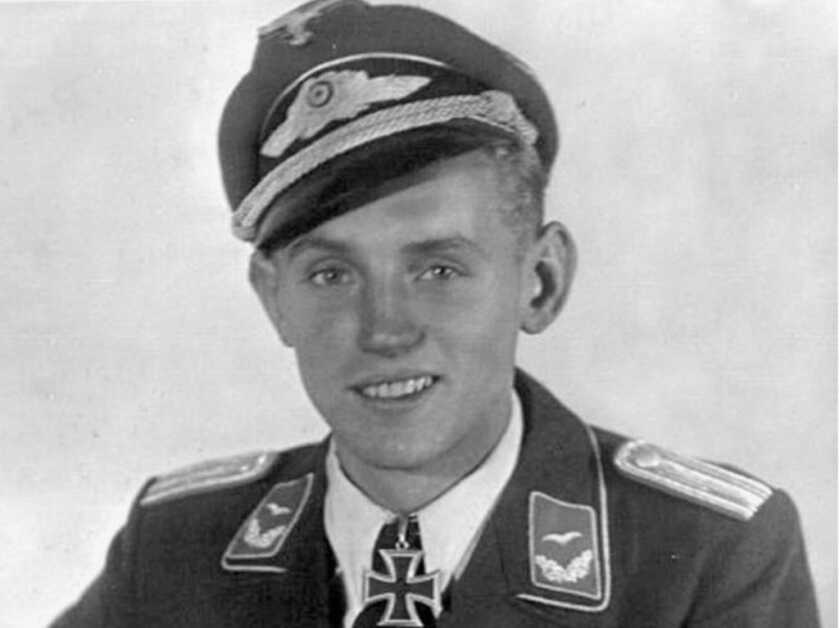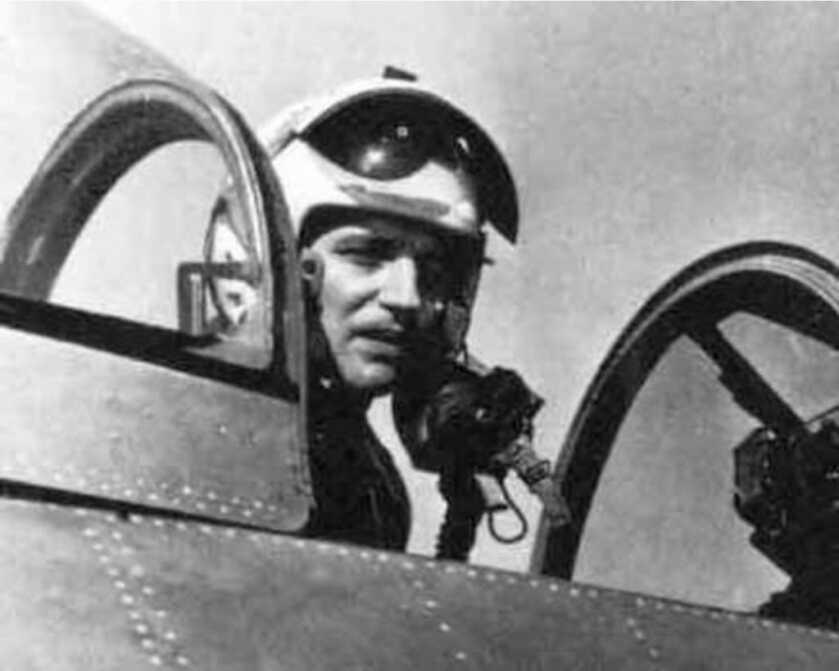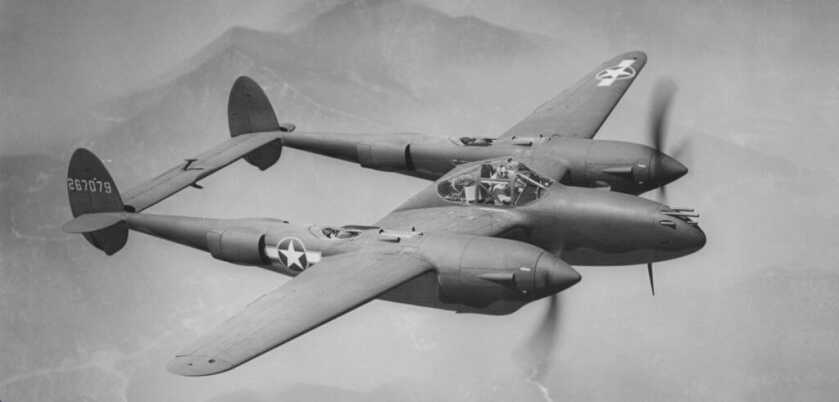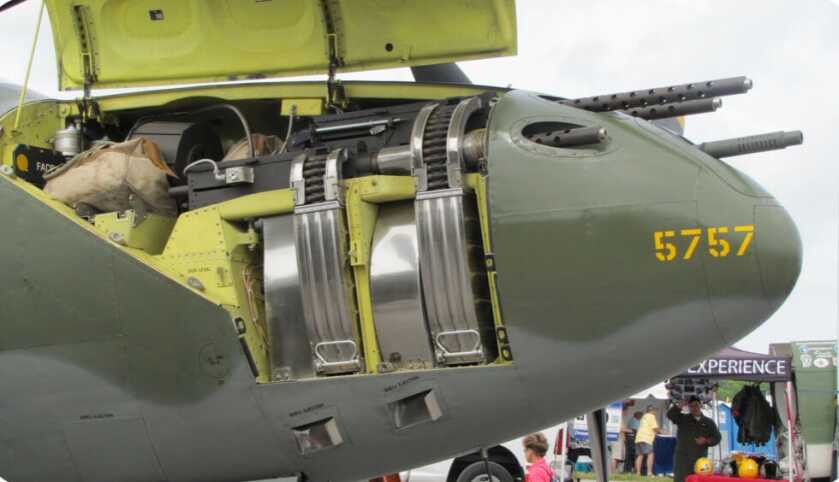
Estimated reading time: 11 minutes
The famed Luftwaffe pilot Major Erich Hartmann was the most successful fighter ace ever, but he had a rocky start. He accidentally taxied a Ju-87 Stuka through a building after a ferry flight before he even saw action. On his first combat mission, Hartmann got fixated and ran his plane out of fuel without hitting an enemy aircraft. He ultimately crash-landed sixteen times. However, by the end of World War 2, he had flown 1,404 combat missions and had been credited with an astounding 352 aerial victories. Seven of his kills were American, while the rest were Russian—all at the controls of the Messerschmitt Bf-109. His tally will never be bested.
Table of contents

Prestigious Pilots
Hartmann shot down his 352d Allied plane mere hours before the war ended. He surrendered to American forces only to be handed over to the Soviets. They were none too grateful for his having shot down some 345 Russian aircraft. He served a decade in a communist gulag before returning to West Germany where he joined the West German Air Force. Hartmann was forcibly retired in 1970 over his opposition to the West German purchase of F-104 Starfighters, which he deemed unsafe. He spent his twilight years as a flight instructor. As a pilot myself I would dearly love to have his signature in my logbook.
By contrast, the leading American ace, Major Richard Bong, had 40 aerial victories. In both cases, these two men were treated like rock stars by their respective governments. Hartmann was awarded the Knight’s Cross with Oak Leaves, Swords, and Diamonds. At the time this was the most prestigious combat decoration offered by the German military.

Major Bong earned the Medal of Honor. Both of these extraordinary aviators were extensively exploited by the media of the day to drum up support for their respective war efforts. So why the massive disparity in kill counts between these two esteemed pilots? That all comes down to national policy and priorities.
Destined to Fly
German aces flew until they died. Aside from the occasional leave, Hartmann flew combat constantly from October 1942 through the end of the war. By contrast, American policy was to rotate successful aces back to the States to sell war bonds and train new generations of pilots. This practice, combined with a seemingly infinite supply of top-quality warplanes, is what helped the Allies win the air war.
Both men later claimed that they were not great shots. Their preferred technique was to approach a target aircraft unawares and engage from close range out of an ambush position. While this seems neither chivalrous nor glamorous, war never is either of those things. The mission was to kill the enemy, and Bong and Hartmann were masters at it.
Before The Croc He Lived in Wisconsin
Richard Bong was born in Superior, Wisconsin, in September of 1920. He went by Dick. He was a compulsive model builder in his youth and played clarinet in his school band. In 1938 Bong enrolled in the Civilian Pilot Training Program and earned his wings. In May of 1941, he enlisted in the US Army Air Corps Aviation Cadet Program. One of his flight instructors was Captain Barry Goldwater who went on to become a US Senator of some renown.

Bong eventually trained to fly the Lockheed P-38 Lightning. The Lightning was, in my opinion at least, the coolest-looking airplane ever to take to the skies. While training in California he was grounded for allegedly looping his twin-engine fighter around the Golden Gate Bridge and buzzing a woman low enough to blow the laundry off her clothesline. Because of this grounding, he missed his squadron’s combat deployment to Europe. As a result, he fell in on the 84th Fighter Squadron of the 78th Fighter Group and deployed to the Pacific theater.
P-38s were in short supply in 1942, so Bong claimed his first two kills at the controls of a P-40 Warhawk. However, by January of 1943 American industry was getting advanced aircraft to the combat zones in quantity. On 26 July 1943, Bong downed four enemy aircraft in a single day flying a Lightning. The young man was on a roll.

Quickly Improving
Dick Bong racked up an impressive record, besting Eddie Rickenbacker’s WW1 score of 26 in April of 1944. Shortly afterwards he returned to the States to sell war bonds and tour fighter training schools. When he returned to the Pacific in September he was assigned to V Fighter Command staff, nominally as a gunnery instructor. In this capacity, his job was simply to hunt Japanese aircraft.
As previously mentioned, Bong often disparaged his own marksmanship. However, one day while flying cover over an aircrew rescue mission he did some remarkably rarefied shooting. It was simply that, in this case, his quarry was not a Japanese warplane.
That Others Might Live…

The area of operations this day was Papua New Guinea. Papua New Guinea occupies the eastern half of New Guinea and represents some of the most forbidding terrain on earth. Mangrove swamps and impenetrable jungles were rife with both malarial mosquitoes and, no kidding, cannibals. It was a particularly sucky place to get shot down.
On the day in question, one of Bong’s fellow aviators had gone down in some particularly nasty jungle. Combat Search and Rescue was not the rarefied art that it is today, so any rescue efforts would be left up to Bong’s squadron. Once they had established the approximate location where this man had gone down, three of Bong’s squadron mates struck out in a tiny boat across an expansive lake in search of him. Bong orbited above to ensure that no Japanese fighter planes crashed the party.

…In A Deadly Place
Papua New Guinea is home to scads of stuff that can kill you. The New Guinea crocodile tops out at around 11 feet and typically keeps to itself. However, the legendary saltwater crocodile that is indigenous to the same area is a freaking monster. I saw these things in Australia back when I deployed there as a soldier in the 1990s, and they were positively prehistoric. Saltwater crocs enjoy a notoriously grouchy disposition and can reach lengths of 21 feet or more.
READ MORE: Don’t Go Into the Swamp: Crocodiles and the Japanese Type 99 Rifle
As Bong’s three mates made their way across this expansive lake in their tiny little boat, the eagle-eyed fighter pilot noted a disturbance in the water behind their craft. Swooping in for a closer look, Bong noted one of these leviathan crocodiles rapidly gaining on the boat. He had no means of communication with the hapless pilots, all three of whom were almost assuredly not aware of the threat steadily approaching from the stern. As such, Bong did what any decent fighter pilot might have done. He armed his guns.
The Airplane That Hit A Crocodile

The P-38 was unique among the pantheon of WW2 fighter aircraft in that it had a combination of four AN/M-2 .50-caliber machineguns along with a single 20mm cannon Hispano M2(C) 20mm cannon all clustered tightly in the nose. Each fifty packed 500 rounds, while the 20mm had 150. More conventional American combat aircraft like the P-40 Warhawk, the P-51 Mustang, and the F4U Corsair sported half a dozen AN/M-2 guns. The fact that those of the Lightning were collocated in the nose offered a greater density of fire and subsequent accuracy potential than aircraft with wing guns that had to be zeroed to converge at a fixed point in the distance.
However, the 20mm produced a lower muzzle velocity than the fifties and subsequently offered disparate ballistics as a result. In a running dogfight that’s not that big a deal. When you’re trying to keep your buddies from being eaten by a crocodile, however, it becomes fairly critical.

Just a Quick Burst of Bullets
Bong deactivated his fifties and left his 20mm hot. Slowing his speed to something comfortable he judged the geometry of the engagement and set up his attack run. By now the enormous predator was getting close to his pals. Pulling back his throttles until the big fighter was in a shallow glide, Bong aligned his glowing reticle with the huge reptile and squeezed off a burst.
A 20-foot crocodile is one of the most formidable predators in the natural world. However, its tough leathery hide is no match for half a dozen 20mm high explosive rounds. Bong blew the beast to pieces without harming his terrified buddies. Dick Bong famously adorned the side of his fighter plane with the smiling visage of his fiancée, Marjorie Vattendahl. Though his plane eventually sported 40 separate Japanese flags representing the enemy aircraft he had downed in combat, there was no indication that Bong ever added the crocodile to his official score.
The Rest of the Story

As the nation’s top-scoring fighter ace, Major Bong was considered a national asset too valuable to risk further in combat. Bong was therefore sent home for good in January of 1945. After marrying Marge and taking a little well-deserved break, Bong assumed duties as a test pilot on the Lockheed P-80 Shooting Star, one of the first American combat jets.

Right to the End
On 6 August 1945, Bong took off in a P-80 to perform an acceptance test flight. It was his 12th hop in the type. The Shooting Star’s fuel pump failed on takeoff, and the plane settled toward a small field at Oxnard Street and Satsuma Avenue in North Hollywood. Bong ejected from the stricken plane, but he was too low for his parachute to open. He died the same day we dropped the atomic bomb on Hiroshima. Newspapers from coast to coast gave both events comparable billing. Major Richard Bong – fighter pilot, national hero, and crocodile hunter – was indeed a proper legend.
*** Buy and Sell on GunsAmerica! ***


Supposedly Bong never read the manuals. Just wanted to punch holes in the sky so to speak. The Jet had a fuel bypass under the pilots seat. After the crash it was examined and there was no indicatiaon of any attempt to turn the bypasses handle. I think Yeaeger mentioned this a few times.
I first learned of Major Bong reading Ed Jablonski’s book, “Air War”, part 1 and 2. It is a great read, covering the WW2 air war from the Stuka’s bombing Poland to Nagasaki, Japan. I really enjoy your articles, Mr Dabbs. I’m praying for a good year for all of us.
I knew of Bong’s general story, but never heard the crocodile account. Thanks for some cool history lesson (I really enjoy all of your stories)! And I agree – definitely not friendly terrain for an emergency landing! 🙂 I did have an engine-out emergency a year or so ago, but thankfully I was in the traffic pattern and able to land on the runway. Much better than amidst crocodiles and swamps!
Oh this is an amazing story I had never read and I studied a lot of World War 2 history ,very entertaining with Mr. Bong shooting the crocodile ,but a real tragedy that he was lost in a testing accident.
I thought it was Rudel who ran his Stuka into a shack on the side of an airfield.
IIRC Hartmann was due at the front as a newly-minted fighter pilot and was told he could ferry a Stuka out to get to his squadron area. I haven’t read the story in a long time, but I don’t think he had ever flown a Stuka before. I seem to recall he got mixed up regarding the brakes and couldn’t stop in time while taxiing into parking.
Another great and informative Dr. Dabbs story
We live about 40 miles south of Poplar, WI his hometown.
If you are ever in Superior, WI the Bong Veterans Historical Center and WW2 Museum is a must see.
I grew up in Bong country; Poplar, Wisconsin. Went to Richard I Bong Memorial school and knew the family but had never heard this story. We heard about him flying under the power lines in Wentworth (next to Poplar). He has always been my hero, but he was not sensational enough to merit the publicity Hollywood et al gives to people. Many times in the war he ran out of film to verify his ‘kills’ so 40 is official and more like 50 unofficial. RIP fine sir.
The P-38 has always been among my favorite WWII aircraft. I’ve watched the films of it hitting tanks and trains in the European theater I remember the history I read of how the plane at first would not come out of a dive, and was nearly deemed a failure until a larger elevator was fitted and a very brave test pilot put it in a dive. He survived with little air between him and the ground. I have also heard that at the end of the war in the Pacific, the planes were deemed obsolete, and a large number were simply pushed of a cliff at the end of the runway. This is supposedly why so few are still around. A sad end if true. Finally, I saw one one day flying along the shore of Lake Michigan when I was a teenager. I was thrilled. My brother and I waved, and the pilot graciously rocked his wings.
Many fine and even new aircraft were scrapped by bull dozer at the end of the war, especially in the remote areas of the CBI & PTO, mainly because there were no pilots to fly them back, and it was a long way back. There is a famous pic of just that, P-38’s being dozed in the CBI. What a waste.
My dad was a gunner on a TBF Avenger and at the end of the war he said he was on an Island (he didn’t specify which) after the war preparing
to leave for the states and saw seabees on dozers shoving numerous new Hellcats and other planes into the sea.